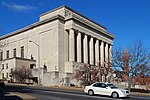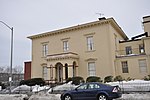Salisbury Mansion and Store
Commercial buildings on the National Register of Historic Places in MassachusettsHistoric house museums in MassachusettsHouses completed in 1772Houses in Worcester, MassachusettsHouses on the National Register of Historic Places in Worcester County, Massachusetts ... and 5 more
Massachusetts museum stubsMuseums in Worcester, MassachusettsNational Register of Historic Places in Worcester, MassachusettsNational Register of Historic Places in Worcester County, MassachusettsWorcester, Massachusetts Registered Historic Place stubs

The Salisbury Mansion and Store is an historic house museum at 40 Highland Street in Worcester, Massachusetts.
Excerpt from the Wikipedia article Salisbury Mansion and Store (License: CC BY-SA 3.0, Authors, Images).Salisbury Mansion and Store
Lancaster Street, Worcester
Geographical coordinates (GPS) Address Nearby Places Show on map
Geographical coordinates (GPS)
| Latitude | Longitude |
|---|---|
| N 42.271944444444 ° | E -71.802777777778 ° |
Address
Highland Street Lot
Lancaster Street
01605 Worcester
Massachusetts, United States
Open on Google Maps











